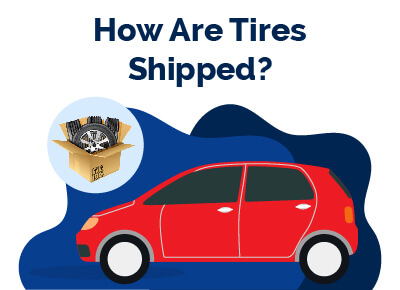How Are Tires Shipped (+ Cost)?
July 22, 2023


Chris is Head of Content for FindTheBestCarPrice and is based out of Philadelphia, PA. As a seasoned automotive industry analyst and car enthusiast, he ensures the highest level of quality across all our content and curates our picks for the best deals each month.
Chris studied information systems and marketing at Drexel University and writes about a wide range of topics ranging from car buying tips to troubleshooting common mechanical issues.
When he’s not thinking about cars, he likes to stay in with his dog and make an “attempt” to finish a crossword puzzle (he’s not quite at the Saturday/Sunday level…yet). As a former cheesemonger, Chris still has a “sharp” passion for all things cheese, and his fridge is always loaded with it!
Chris also has a passion for things that go fast, and drones are no exception. He spends some of his time writing for Dronesourced.
Irrespective of the platform, be it Amazon, eBay, Shopify, or any other, tires are sold daily across the United States and globally. The collective consignment of U.S. tires in 2021 accounted for approximately 330 million units.
Tires and wheels vary in dimensions and mass, so they can impact the shipping fee.
While shipping tires may be a facile task for the proficient, it can be challenging and arduous for others. If not carried out precisely, tires may suffer damage before arriving at their destination.
The encouraging news is that one can acquire expertise in shipping tires, from packaging to computing the shipping charges. This blog post comprehensively addresses all your queries regarding how tires are shipped, including how much it costs to ship tires.
Let’s get started!
Table of Contents
- How To Ship Tires Without Wheels
- How To Ship Tires With Wheels
- 1. Get Rid of Nuts and Bolts Capable of Damaging the Wheels
- 2. Secure the Center With Tapes
- 3. Lay Foam Sheets on the Surface of the Wheel
- 4. Place Circular Cardboard on Both Sides of the Wheel
- 5. Put the Tires in a Cardboard Box
- 6. Add Some Cushion Materials Inside the Box
- 7. Seal the Box and Add Shipping Labels
- Acceptable Practices for Shipping Tires
- Cost of Shipping Tires and Wheels
- Can You Ship Tires With USPS?
- Can You Ship Tires With UPS?
- Can You Ship Tires With FedEx?
- How Long Does It Take To Ship Tires?
- Best Car Deals by Category
How To Ship Tires Without Wheels
Transporting a tire without a wheel or rims can be effortless. As an illustration, FedEx mandates no specific packaging measures; affix a tire label on the tread surface and hand it over to FedEx.
Alternatively, one may provide additional safeguarding to the tires during shipping by boxing them or firmly wrapping them in plastic.
In cases where multiple tires are to be shipped to the same endpoint, it is prudent to calculate whether bundling them together in a box would be more cost-effective than labeling each tire individually.
How To Ship Tires With Wheels
Appropriate preparation is paramount if you intend to guarantee your tire's safety while in transit.
Unlike typical items, packaging a tire for transportation necessitates additional attention and meticulousness. Adhere to the following guidelines to adeptly package tires:
1. Get Rid of Nuts and Bolts Capable of Damaging the Wheels
Unsecured hardware, such as lug nuts or bolts, threatens the wheel's integrity, particularly while in transit.
Conduct a comprehensive tire inspection to identify loose fasteners and promptly detach them to mitigate potential harm.
2. Secure the Center With Tapes
The aluminum alloy composing the wheel's center cap is susceptible to either expansion or contraction, contingent on the ambient temperature. If the cap is not appropriately affixed, it may disengage during movement.
As a preventive measure, it is advisable to ensure the center cap is secure throughout the journey.
Employing adhesive tape is a practical solution to prevent dislodgment; this will maintain the center cap's position and prevent it from disengaging.
3. Lay Foam Sheets on the Surface of the Wheel
To preserve the wheels, lay foam sheets on the wheel's surface. Proceed to place additional foam sheets to create a cushioning layer between the wheel and the cardboard.
Finally, use adhesive tape to anchor the foam sheets and ensure they remain affixed.
4. Place Circular Cardboard on Both Sides of the Wheel
Excise circular sections of cardboard to envelop the wheel, utilizing old shipping boxes to serve this purpose.
Notably, the rubber component of the tire necessitates no coverage by cardboard. Therefore, there is no cause for concern if the rubber is exposed. In its stead, apply a plastic wrap to envelop the entire tire when securing the wheel.
5. Put the Tires in a Cardboard Box
It may be placed within a suitable box upon firmly packing the tire. A properly-sized container may be procured from your chosen carrier.
Before insertion, confirm that the chosen box is sufficiently roomy to accommodate both the tire and its corresponding cushioning materials.
6. Add Some Cushion Materials Inside the Box
Tires are not inherently delicate, although their rubber surface is susceptible to punctures and abrasions.
As a precautionary measure, it is judicious to incorporate ample cushioning materials within the box to ensure the tire remains securely in place during transit.
7. Seal the Box and Add Shipping Labels
After tightly and safely packing the tire within the box, utilize adhesive tape to seal the package securely, ensuring that every aperture is thoroughly covered.
Subsequently, attach a shipping label bearing the intended address onto the package once all is ready.
Acceptable Practices for Shipping Tires
The following are best practices for shipping tires:
Before shipping your tires, it is recommended to deflate them to enhance their cushioning properties slightly.
Deflation causes the rubber to become more yielding and the sides to become thicker, thereby improving the wheels' protection during transit.
To safeguard your tires and prevent damage, it is essential to utilize ample cushioning materials while packing, including the wheel, cap, and rubber. Ensure the packing is tightly sealed before shipping to avoid any potential problems.
Applying multiple layers of tape while sealing the shipping box is advisable. The more layers of tape applied, the better the box's security.
Shipping insurance is highly recommended to protect against losses, theft, or package damage. In case of any untoward incident during transit, the customer is guaranteed a cashback guarantee.
Consider using a shipping platform to prepare for shipping tires effectively. Shipping platforms offer software tools for tire shipping, including calculators to determine the most suitable shipping carrier rates.
Moreover, postage can be printed directly from the software, reducing the shipping process's overall stress.
Cost of Shipping Tires and Wheels
Shipping a package containing both tires and wheels typically weighs approximately 50 pounds.
However, this weight can vary depending on the tire's size, wheel construction, and rim materials.
The shipping cost will also vary depending on the distance the package must travel. Ground services from UPS or FedEx can range from approximately $21 for Zone 2 to around $62 for Zone 8.
When shipping a package containing tires and wheels, the package will not be subject to dimensional weight pricing.
However, it's worth noting that shipping a tire quickly can sometimes pose a challenge due to weight limits.
For example, UPS Express will not handle packages over 50 pounds, and FedEx Express and Ground may charge a surcharge of up to $36 for packages weighing over 50 pounds.
Pro tip: Size and weight surcharges may increase during peak holiday shipping seasons. To avoid these costs, consider shipping your tires and rims before October or after mid-January.
Can You Ship Tires With USPS?
If you plan to transport tires, you can use USPS to convey them to the buyer at a charge based on the package's weight and destination.
Before you send your tires, you should know the total cost so you can include it in your pricing.
Thankfully, USPS offers an online shipping calculator that allows you to enter inputs such as tire weight, destination, zip codes, service level, and dates to compare prices and delivery times.
Compared to other logistics companies, this tool removes any guesswork, enabling you to determine the best and most cost-effective option.
According to some customers who have used USPS for tire shipping, the costs typically range from $15 to $25, while others have incurred higher expenses.
Moreover, USPS provides guidelines that you can use to determine mailability and whether dimensional weight, oversized prices, and balloon rates apply when shipping.
Can You Ship Tires With UPS?
UPS provides tire shipping services, and their packaging guidelines require customers to use a broad strip of pressure-sensitive tape running across the center of the tire and, subsequently, use the same tape to envelop the tire's entire body.
When labeling the package, it is advisable to affix the completed address label on the tape strip covering the tire's tread and then seal the label with transparent tape for added protection.
Can You Ship Tires With FedEx?
If you intend to transport your tires via FedEx, the logistics company offers specific guidelines to assist customers in packing their tires for effective delivery.
Per their specifications, their domestic services can accommodate tire shipments. The standard shipping alternative is solely available for passenger cars, vans, or any tires under 17 inches, with an outer diameter not surpassing 700 mm or 35 kg.
To ship via FedEx, you must package your tires in either round covers, single cardboard sheets, stretch, or shrink wrap.
Remember that FedEx doesn't provide packaging materials, so arranging them before dispatching the tires for shipping is advisable.
To approximate your total shipping costs, you can leverage FedEx's rate tools accessible on their website before sending your tires.
How Long Does It Take To Ship Tires?
The expected delivery time for your tires relies on factors such as the chosen shipping service and the distance between the origin and destination.
However, the delivery timeframe can fluctuate if you purchase tires from a retailer or manufacturer.
For example, Discount Tires takes approximately 2 to 4 business days to deliver, depending on the shipping origin, while Tire Rack takes 1 to 2 business days.
Best Car Deals by Category
Posted in Car Buying Tips, Car Troubleshooting |




